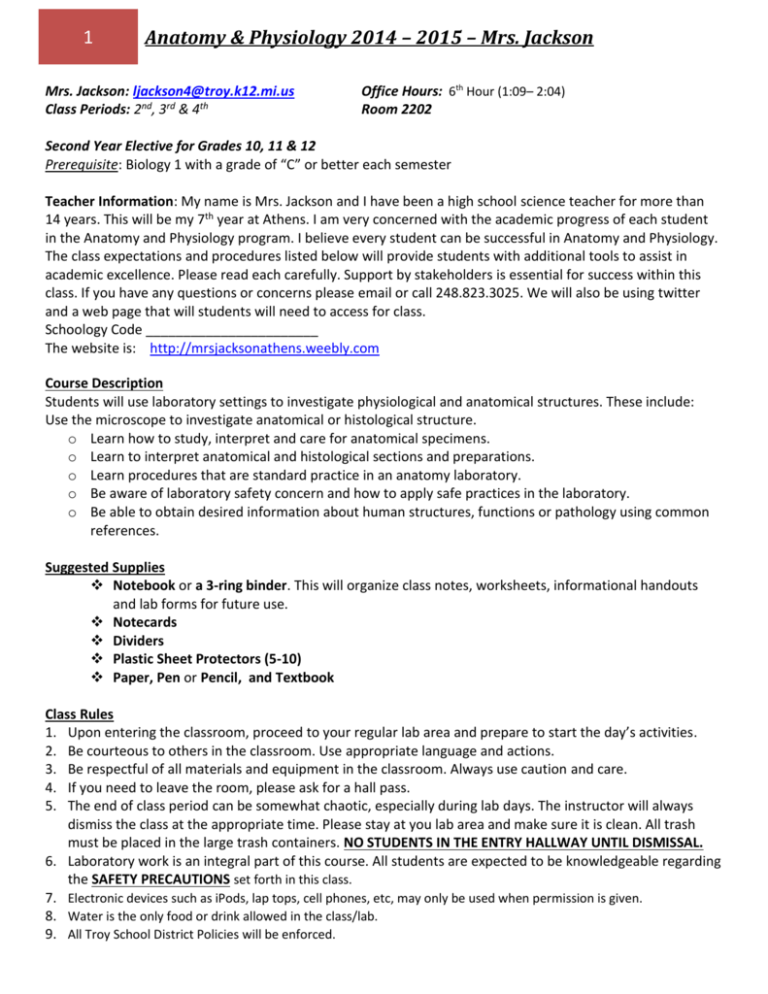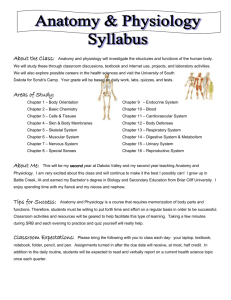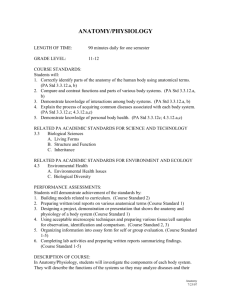Syllabus - AHS Anatomy & Physiology
advertisement

1 Anatomy & Physiology 2014 – 2015 – Mrs. Jackson Mrs. Jackson: ljackson4@troy.k12.mi.us Class Periods: 2nd, 3rd & 4th Office Hours: 6th Hour (1:09– 2:04) Room 2202 Second Year Elective for Grades 10, 11 & 12 Prerequisite: Biology 1 with a grade of “C” or better each semester Teacher Information: My name is Mrs. Jackson and I have been a high school science teacher for more than 14 years. This will be my 7th year at Athens. I am very concerned with the academic progress of each student in the Anatomy and Physiology program. I believe every student can be successful in Anatomy and Physiology. The class expectations and procedures listed below will provide students with additional tools to assist in academic excellence. Please read each carefully. Support by stakeholders is essential for success within this class. If you have any questions or concerns please email or call 248.823.3025. We will also be using twitter and a web page that will students will need to access for class. Schoology Code _______________________ The website is: http://mrsjacksonathens.weebly.com Course Description Students will use laboratory settings to investigate physiological and anatomical structures. These include: Use the microscope to investigate anatomical or histological structure. o Learn how to study, interpret and care for anatomical specimens. o Learn to interpret anatomical and histological sections and preparations. o Learn procedures that are standard practice in an anatomy laboratory. o Be aware of laboratory safety concern and how to apply safe practices in the laboratory. o Be able to obtain desired information about human structures, functions or pathology using common references. Suggested Supplies Notebook or a 3-ring binder. This will organize class notes, worksheets, informational handouts and lab forms for future use. Notecards Dividers Plastic Sheet Protectors (5-10) Paper, Pen or Pencil, and Textbook Class Rules 1. Upon entering the classroom, proceed to your regular lab area and prepare to start the day’s activities. 2. Be courteous to others in the classroom. Use appropriate language and actions. 3. Be respectful of all materials and equipment in the classroom. Always use caution and care. 4. If you need to leave the room, please ask for a hall pass. 5. The end of class period can be somewhat chaotic, especially during lab days. The instructor will always dismiss the class at the appropriate time. Please stay at you lab area and make sure it is clean. All trash must be placed in the large trash containers. NO STUDENTS IN THE ENTRY HALLWAY UNTIL DISMISSAL. 6. Laboratory work is an integral part of this course. All students are expected to be knowledgeable regarding the SAFETY PRECAUTIONS set forth in this class. 7. Electronic devices such as iPods, lap tops, cell phones, etc, may only be used when permission is given. 8. Water is the only food or drink allowed in the class/lab. 9. All Troy School District Policies will be enforced. 2 Anatomy & Physiology 2014 – 2015 – Mrs. Jackson Classroom Philosophy The majority of the Anatomy and Physiology class is laboratory based. You will be asked to work closely with a partner throughout the year. You will be expected to be actively engaged throughout each class period and be a contributing member the class and partnership. This includes taking notes, asking probing questions, investigating ideas outside of class and requesting help and clarification when needed. **Please understand that EACH student must set time aside to STUDY and PRACTICE APPLICATION of laboratory investigations. This aspect varies with each person but a quiet and comfortable area leads to increased concentration and hopefully appropriate results. Absences: You are responsible for obtaining all assignments, notes, laboratory information, etc. when you are absent. Please check the calendar and the assignment board to ensure that you have received all assignments and information that was given. You will not receive credit for test, quizzes or assignments missed due to an unexcused absence. The Troy Athens attendance policy will be followed. Academic Integrity You are responsible for completing your own work. Involvement in any form of cheating (giving or receiving answers to ANY assignment or assessment) will result in a zero for the grade. Additional Assistance Anyone interested in addition laboratory time or individual assistance is welcome to schedule time/times to come in before or after school. Most weeks I will be available after school Monday, Tuesday, Thursday and Friday until 2:30. If these times do not work with your schedule please ask to schedule a specific time and I will do my best to work with you. Textbook Holes’s Essentials of Human Anatomy and Physiology is the text we will use as a reference in class. o You will be assigned a textbook. o You may leave your textbook at home to complete assignments and reference information. o We will have a class set of textbooks to use while in the classroom. Assessment and Evaluation Your grade will be calculated based on the following components: o Tests o Quizzes o Homework o Lab Semester Grades o 1st Marking Period = 40% o 2nd Marking Period = 40% o Semester Exam = 20% 3 Anatomy & Physiology 2014 – 2015 – Mrs. Jackson Grading Students are highly encouraged to keep track of the grades received on the following: Tests – Tests and Quizzes will represent 80 – 90% of your quarter grade. o Tests will be given at the end of each topic and/or unit. The test may be written, laboratory practical, oral or any combination of the three. o TESTS WILL ALWAYS BE ANNOUNCED WITH PLENTY OF TIME FOR PREPARATION. (You will receive a calendar for each unit with dates of completion.) o Make-up tests will be different and must be accomplished without delay. Quizzes o In most instances quizzes will be 15 – 30 points. o Consistently prepare for each quiz. They will be an integral part of your grade. o Quizzes are intended to let you know how you are progressing in the understanding and application of knowledge with regard to the topic/unit. o Make-up quizzes will be different and must be accomplished without delay. o QUIZ SCALE: DOUBLE FOR A 30 POINT QUIZ 15 = A 13 = B 11 = C 9=D 14 = A12 = C10 = D+ 8-0 = E Homework o Each student will have homework every day. There may or may not be an assignment collected the next day but it is expected that students will work toward understanding and completion each day. o HOMEWORK will be accepted only on the date that it is due. (Refer to unit calendar.) o If you must be absent from class, please have the absence excused per the school attendance policy. o All work must be finished within a prescribed period of time. o Each student must acquire the assignment from the assignment log/calendar, another student or the instructor. THIS IS THE STUDENT’S RESPONSIBILITY! o CORRECT SPELLING is a requirement on all homework, quizzes and tests. In most cases, each student will know which terms must be spelled correctly on quizzes and tests. It will be marked wrong if the answer is spelled incorrectly. Please ensure correct spelling when reviewing for these types of assignments. o Grades will be updated on Edline periodically. o GRADING OF WRITTEN HOMEWORK -10% to 20% of QUARTER GRADE Generally homework will be graded with a possible 20 points on each assignment despite of the number of answers. Example: A homework paper has 28 answers. If a student were to receive 20 on the work, he would have to have all 28 answers correct. If a student had 24/28 answers correct, the 4 incorrect answers are subtracted from the 20 and a grade of 16 would result, which is a C+. In other words, a partial effort would not result in an adequate grade for the assignment. Obviously, the assignment is a also a major concern and necessity. SCALE FOR HOMEWORK: 20 = A 17 = B 14 = C-/D+ 11 – 0 = E 19 = A16 = B13 = D 18 = B+ 15 = C 12 = D- 4 Anatomy & Physiology 2014 – 2015 – Mrs. Jackson Emergency Procedure Should an emergency occur remain calm. If a student is in distress and needs assistance please inform me immediately. Please be attentive and listen for instructions from your teacher. Follow the directions and/or the emergency plan that is in place for the classroom. Laboratory Expectations Please be very careful in the lab area, there will be very expensive materials located throughout the room. We cannot tolerate damage caused by neglectful individuals. Use proper lab techniques to avoid injury. Please be on time to class: Tardies distract class activities and can alter your performance on lab related events. Each lab may have very specific guidelines but the following will apply to every lab setting: o No food or drink of any kind. o No personal grooming. o No loud talking, normal tones will suffice. o Do not distract (disturb) other members of the class. o Always return materials to the proper lab area. o Always return and/or leave equipment clean. o Always leave your lab area organized and clean. o Push your chair in when you leave for the day. Finally, always feel free to ASK QUESTIONS. We are here to assist you in your education goals. Therefore, do not hesitate to ask questions or respond to questions. Problems solved early eliminate future anxieties. Think about this…… Critical thinking is the ability to think clearly and rationally. It includes the ability to engage in reflective and independent thinking. Someone with critical thinking skills is able to do the following: understand the logical connections between ideas identify, construct and evaluate arguments detect inconsistencies and common mistakes in reasoning solve problems systematically identify the relevance and importance of ideas reflect on the justification of one's own beliefs and values. 5 Anatomy & Physiology 2014 – 2015 – Mrs. Jackson 1st Semester Tentative Outline (Assignments and Assessments are subject to change) Unit: (Corresponding Chapters In Textbook) st 1 Marking Period Introduction to Anatomy & Physiology Chapters: 1, 2, 3 & 7 1st Marking Period Histology Chapters: 5, 6, 8 & 12 What you should learn 2nd Marking Period Osteology Chapters 7 Understanding of anatomical terminology and language Levels of organization in the body Different types of tissue in the human body Specialized function of each tissue type Anatomical structure of tissues Understanding of how tissues work together Identification of tissues Active tissues in bone Bone structure Bone development and growth Bone function Skeletal organization Indentify : o Bones and Anatomical Landmarks of Pelvic Girdle & Lower Limb o Bones Anatomical Landmarks of Pectoral Girdle and Upper Limb o Bones Anatomical Landmarks of the Spinal Column and Ribs o Bones Anatomical Landmarks of the Skull Major Assignments/Assessments Quizzes: o 4 terminology and language o 1 over Organization of the Body Test: Entire Unit Histology Information Packet Histology Comparison Chart Epithelial, Connective, Muscle, Nervous and Hemopoietic Tissue Assignments 4 Mini-Lab Practicals: Identification & Function of Tissues Big Ten Lab Practical: Identification & Function of Tissues Major Lab Practical Unit Project – Specialized Tissue Chapter 7 Terms Bone survey Osteology and Terminology Joints Worksheet Quizzes: Chapter 7, Terminology, Bone Structure and Function, Joints, Reading Packet Written Quizzes, Tables 7.1 & 7.2 Oral Tests: Lower Extremity, Upper Extremity, Spine and Skull Major Lab Practical - Osteology 6 Anatomy & Physiology 2014 – 2015 – Mrs. Jackson 2nd Semester Tentative Outline (Assignments and Assessments are subject to change) Unit: (Corresponding Chapters In Textbook) rd 3 Marking Period Introduction to Muscle Chapters 5, 8, 9 & 13 What you should learn 3rd Marking Period Cat Dissection – Lower and Upper Extremities and Abdominal Wall Chapters: 5, 6, 8, 9, 12 & 13 Describe how connective tissue is associated with muscle tissue within a skeletal muscle. Name and locate the major structures of a skeletal muscle fiber (on a model or picture). Distinguish between the origin and insertion of a muscle. Use your understanding of anatomical terminology and language to locate muscles of the body. Location and identification of the muscles that move the thigh, leg and foot Describe the action of these muscles. Location of the origin and insertion of these muscles. Location and identification of the nerves that move the thigh, leg and foot Location and identification of the blood vessels that supply blood to the thigh, leg and foot Location and identification of the muscles that move the chest, shoulder and upper limb Describe the action of these muscles. Location of the origin and insertion of these muscles. Location and identification of the nerves that move the chest, shoulder and upper limb Location and identification of the blood vessels that supply blood to the chest, shoulder and upper limb Major Assignments/Assessments Chapter 8 Worksheet Chapter 8 Quiz Anatomy Terms Quizzes o Prefix/suffix o Directional Muscle Origin/Insertion Worksheet Dissection of the muscles, nerves and blood vessels of the thigh, leg and foot Lower Extremity Dissection Grades (300 points total) Partner Pin Quizzes = 3 (Lower Extremity) 3 – 4 Written Quizzes (Lower Extremity) MLP for structures 1 – 33 Lower Extremity Oral Test over structures of the Lower Extremity Dissection of the muscles, nerves and blood vessels of the chest, shoulder and upper limb Upper Extremity Dissection Grades ( points total) 4 Written Quizzes (Upper Extremity) 2 MLP’s over Upper Extremity Major Lab Practical for the Upper Extremity Partner Pin Quizzes = 3 Written Quizzes = 3 MPL over all organs and structures Partner Pin Quiz = Blood Vessels Written Quiz = Blood Vessels Major Lab Practical of Abdominal and Thoracic Cavities and Blood Vessels 4th Marking Period Cat Dissection – Abdominals and Thoracic Cavities and Muscles of the Neck Chapters: 5, 6, 8, 9, 12, 13, 15, 16, 17, & 19 Locate and identify the muscles of the abdominal wall. Describe the action of each of these muscles. Locate the origin and insertion of each of these muscles. Locate and identify the structures of the abdomen (linings of the peritoneal cavity, ligaments, mesenteries, organs, etc) Location and identify the arteries and veins of the abdominal and thoracic cavities Location of thoracic cavity structures 7 Anatomy & Physiology 2014 – 2015 – Mrs. Jackson Mrs.Jackson’s Classroom Expectations and Guidelines Acknowledgement Please sign below after reviewing the rules, requirements, attendance policy, and grading policy. Please feel free to contact me at any time if you have any questions or concerns. Also, please include your email address and daytime phone number so that, if necessary, I may reach you. Thank you and I hope to meet you at open house on Wednesday, September 17, 2014! We have read, discussed, and understand the expectations and guidelines for Mrs.Jackson’s class. Student Name: (please print)__________________________________Hour: ______________ Student Signature: __________________________________________ Date: _____________ Parent/Guardian Name: (please print) _________________________ Parent/Guardian signature: ___________________________________ Date: _____________ Parent/Guardian daytime phone #: _______________________________________________ Parent/Guardian email address: ________________________________________________ Students…..please return this signed letter along with the signed science safety form to Mrs. Jackson by September 4, 2014. Thursday,




